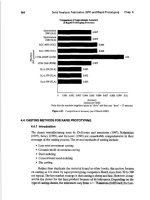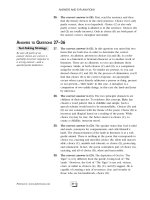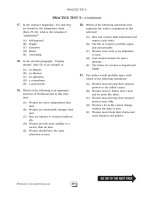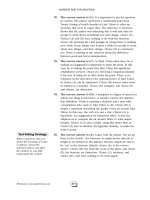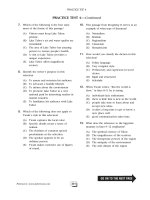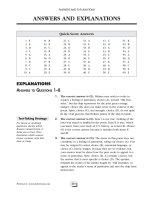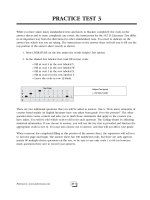SAT II success literature Episode 1 Part 9 pot
Bạn đang xem bản rút gọn của tài liệu. Xem và tải ngay bản đầy đủ của tài liệu tại đây (102.78 KB, 20 trang )
Questions 39–45 refer to the following poem. Read the passage
carefully and then choose the best answer for each question.
Spring
Line Nothing is so beautiful as Spring–
When weeds, in wheels, shoot long and lovely and lush;
Thrush’s eggs look little low heavens, and thrush
Through the echoing timber does so rinse and wring
The ear, it strikes like lightnings to hear him sing;
The glassy peartree leaves and blooms, they brush
The descending blue; that blue is all in a rush
With richness; the racing lambs too have fair their fling.
What is all this juice and all this joy?
A strain of the earth’s sweet being in the beginning
In Eden’s garden.—Have, get, before it cloy.
Before it cloud, Christ, lord, and sour with sinning,
Innocent mind and Mayday in girl and boy,
Most, O maid’s child, thy choice and worthy the winning.
—Gerard Manley Hopkins
39. Which of the following indicate that
“Spring” is a Petrarchan sonnet?
I. The rhyme scheme of the first eight
lines
II. The theme is presented in the first
eight lines and the resolution in the
final lines.
III. The ending couplet
(A) I only
(B) II only
(C) III only
(D) I and II
(E) II and III
40. The phrase “rinse and wring” (line 4) is a
reference to the action of
(A) the ocean.
(B) the spring rain.
(C) a river.
(D) washing clothes.
(E) a thunderstorm.
41. What figurative language is present in the
second line of the poem?
(A) Personification
(B) Simile
(C) Metaphor
(D) Onomatopoeia
(E) Assonance
PRACTICE TEST 1
PRACTICE TEST 1—Continued
5
10
➡
GO ON TO THE NEXT PAGE
151Peterson’s: www.petersons.com
42. What is the main idea of the poem?
(A) Spring is nature’s most beautiful
season.
(B) It is hopeless to search for the
beautiful beginning of life in Eden.
(C) Religious belief is crucial to people’s
well being.
(D) Nothing is as beautiful as spring, but
the beauty of nature can sour the
innocence of people.
(E) Spring can be marred by elements of
nature.
43. Which of the following is evident in line 9?
(A) Personification
(B) Hyperbole
(C) Metaphor
(D) Parallel construction
(E) Conceit
44. All of the following are examples of images
of motion and movement in the poem
EXCEPT
(A) “When weeds, in wheels, shoot long
and lovely and lush” (line 2).
(B) “it strikes like lightnings” (line 5).
(C) “they brush the descending blue”
(lines 6 and 7).
(D) “the racing lambs too have fair their
fling” (line 8).
(E) “Before it cloud” (line 12).
45. The tone of this poem is
(A) meditative and reverent.
(B) moving and uplifting.
(C) admiring and encouraging.
(D) respectful yet admonishing.
(E) mystical and lush.
SAT II SUCCESS: LITERATURE
PRACTICE TEST 1—Continued
152 Peterson’s SAT II Success: Literature
Questions 46–53 refer to the following selection. Read the passage
carefully and then choose the best answer for each question.
Washington, 21 November, 1800
My Dear Child:
Line . . . woods are all you see from Baltimore until you reach the city,*
which is only so in name. Here and there is a small cot, without a
glass window, interspersed amongst the forests, through which you
travel miles without seeing any human being. In the city there are
buildings enough, if they were compact and finished, to accommo-
date Congress and those attached to it; but as they are, scattered as
they are, I see no great comfort for them. The river, which runs up to
Alexandria, is in full view of my window, and I see the vessels as
they pass and repass. The house is upon a grand and superb scale,
requiring about thirty servants to attend and keep the apartments in
proper order, and perform the ordinary business of the house and
stables; an establishment very well proportioned to the President’s
salary. The lighting of the apartments, from the kitchen to the parlors
and chambers, is a tax indeed; and the fires we are obliged to keep to
secure us from daily agues is another very cheering comfort. To assist
us in this great castle, and render less attendance necessary, bells are
wholly wanting, not one single one being hung through the whole
house, and promises are all you can obtain. This is so great an
inconvenience, that I know not what to do, or how to do [I]f
they will put me up some bells and let me have wood enough to
keep fires, I design to be pleased. I could content myself almost
anywhere three months; but, surrounded with forests, can you
believe that wood is not to be had because people cannot be found
to cut and cart it?
You must keep all this to yourself, and when asked how I like it,
say that I write you the situation is beautiful, which is true. The
house is made habitable, but there is not a single apartment
finished Ifthetwelve years, in which this place has been
considered as the future seat of government, had been improved, as
they would have been if in New England, very many of the present
inconveniences would have been removed. It is a beautiful spot,
capable of every improvement, and the more I view it, the more I am
delighted with it.
—Abigail Adams
* Washington, D.C.
PRACTICE TEST 1
PRACTICE TEST 1—Continued
5
10
15
20
25
30
➡
GO ON TO THE NEXT PAGE
153Peterson’s: www.petersons.com
46. What effect does the speaker’s point of
view have on the reader’s experience of
this selection?
(A) The first person singular point of
view conveys realism and a sense of
urgency to the reader.
(B) The first person singular point of
view gives the reader the speaker’s
viewpoint and experience, unfiltered.
(C) The first person plural point of view
brings the reader into the experience
as a partner.
(D) The first person plural point of view
more fully engages the reader’s
attention.
(E) The second person singular point of
view addresses the audience directly.
47. Which of the following best describes the
tone of the letter?
(A) Carping, disillusioned
(B) Polite, informative
(C) Light, amusing
(D) Intimate, confiding
(E) Angry, resentful
48. Given the excerpt, which of the following
statements best summarizes Abigail
Adams’s message to her daughter?
(A) Washington, D.C. is not much of a city.
(B) I will never enjoy living in this cold,
unfinished mansion.
(C) I feel very isolated living in this house
and in this city.
(D) Please do not share this information.
(E) There is much to do, but I am equal
to the task.
49. The writer’s description of the White
House and the city of Washington, D.C.,
show them to be alike in that they are
both
I. unfinished, with little potential.
II. beautiful, but wanting improvement.
III. undeveloped, uninhabited.
(A) I only
(B) II only
(C) III only
(D) I and II
(E) I and III
50. Which of the following best describes the
writer’s method of organization in the
letter?
(A) Linear
(B) Developmental
(C) Order of importance
(D) Chronological
(E) Spatial
51. In the clause “and the fires we are obliged
to keep to secure us from daily agues”
(lines 14–15), what is the meaning of the
word “agues”?
(A) Aches and pains
(B) Coughing and sniffling
(C) Chills and fever
(D) Flu symptoms
(E) Arthritis
SAT II SUCCESS: LITERATURE
PRACTICE TEST 1—Continued
154 Peterson’s SAT II Success: Literature
52. Which of the following is not true of this
passage?
(A) The selection uses elegant diction.
(B) The vocabulary shows the writer to
be educated.
(C) The language is descriptive.
(D) The writer employs strong visual
images.
(E) The sentence structure is abstruse.
53. All of the following details are used to
create the impression of inconvenience in
the new White House EXCEPT
(A) not enough servants.
(B) too little wood.
(C) difficult lighting.
(D) not a single apartment finished.
(E) no bells whatsoever for ringing the
servants.
PRACTICE TEST 1
PRACTICE TEST 1—Continued
➡
GO ON TO THE NEXT PAGE
155Peterson’s: www.petersons.com
Questions 54–60 refer to the following poem written in eighteenth-
century England. Read the passage carefully and then choose the best
answer for each question.
Holy Thursday
Line Is this a holy thing to see,
In a rich and fruitful land?
Babes reduced to misery,
Fed with cold and usurious hand.
Is that trembling cry a song?
Can it be a song of joy?
And so many children poor?
It is a land of poverty!
And their sun does never shine,
And their fields are bleak and bare,
And their ways are filled with thorns;
It is eternal winter there.
For where-e’er the sun does shine,
And where-e’er the rain does fall,
Babe can never hunger there,
Nor poverty the mind appall.
—William Blake
54. This poem is a(n)
(A) sonnet.
(B) epic.
(C) narrative.
(D) ballad.
(E) lyric.
55. What is the poet’s purpose in writing the
poem?
(A) To explain an important religious
holiday
(B) To validate the joys and sorrows of
children
(C) To extol the wealth and prosperity of
the England of the Industrial Revolu-
tion
(D) To bring attention to the miserable
conditions of the urban poor in
industrial England
(E) To satirize the society of the period
SAT II SUCCESS: LITERATURE
PRACTICE TEST 1—Continued
5
10
15
156 Peterson’s SAT II Success: Literature
56. In the final stanza, what does Blake appeal
to in his readers?
I. Their emotions
II. Their faith
III. Their reason
(A) I only
(B) II only
(C) III only
(D) I and III
(E) I, II, and III
57. What contrast does Blake establish in the
first two stanzas?
(A) A fruitful land and poor children
(B) England as a rich land and England as
an impoverished land
(C) A land that is dark and bleak and a
land where the sun shines
(D) Eternal winter and eternal summer
(E) A song of joy and a song of sorrow
58. What is the effect of the parallel structure
in lines 13 and 14?
(A) The lines introduce the conclusion.
(B) They support the poet’s contention
that England is a rich land.
(C) They make the poem seem musical.
(D) They explain the title.
(E) They reinforce the contrast between
the poverty and the ideal.
59. Which of the following is present in the
poem?
I. Alliteration
II. Consonance
III. Assonance
(A) I
(B) II
(C) III
(D) I and III
(E) I, II, and III
60. In line 10, how do the b sounds and the
long e sounds reinforce the meaning?
(A) The harsh sounds suggest the sounds
of crying and sadness.
(B) The coldness of the b’s and e’s
reinforces the coldness of winter.
(C) These sharp sounds mirror the
thorns.
(D) These cheerful sounds suggest a
fruitful land.
(E) The sonorous sounds of the letters
imply a religious ritual.
STOP
If you finish before the hour is up, you may review your work on this test only. You may not turn to
any other test in this book.
PRACTICE TEST 1
PRACTICE TEST 1—Continued
157Peterson’s: www.petersons.com
ANSWERS AND EXPLANATIONS
Quick-Score Answers
1. A
2. D
3. C
4. A
5. B
6. C
7. B
8. A
9. C
10. A
11. B
12. C
13. D
14. A
15. D
16. D
17. B
18. E
19. D
20. B
21. C
22. B
23. C
24. B
25. D
26. E
27. C
28. B
29. E
30. B
31. D
32. A
33. C
34. E
35. B
36. E
37. C
38. B
39. D
40. D
41. E
42. D
43. D
44. E
45. A
46. B
47. D
48. E
49. B
50. D
51. C
52. E
53. A
54. E
55. D
56. E
57. B
58. E
59. E
60. A
EXPLANATIONS
ANSWERS TO QUESTIONS 1–9
Review Strategy
See A Quick Review of
Literary Terms, chapter 4.
1. The correct answer is (C). First, recall the definition of
personification—the attribution of human qualities to a nonhu-
man or an inanimate object. You can eliminate choices (A) and
(E) immediately. To call buds darling, choice (A), is not to give
them a human attribute, but merely to describe them. The eyes
belong to men in line 13, so choice (E) is incorrect. Choice (B)
can be eliminated because a lease is not a human quality,
although humans may have leases to things. Choice (D), “na-
ture’s changing course,” refers to alterations that occur in the
nature, so no human qualities are involved, eliminating this
answer. “His gold complexion” in line 6, choice (C), extends the
image in line 5 “too hot the eye of heaven,” which refers to the
sun. Both are examples of personification, making choice (C) the
correct answer.
2. The correct answer is (D). The beloved is “more lovely and
more temperate” than a summer’s day, thus making choice (A)
contrary to what the speaker says. Choice (C) also contradicts
the speaker because he says his beloved will live on “in eternal
lines.” Choice (E) is incorrect for the same reason. Choice (B)
makes no sense in the context of the poem, so it can be
eliminated. Choice (D) is supported by the last seven lines.
SAT II SUCCESS: LITERATURE
158 Peterson’s SAT II Success: Literature
3. The correct answer is (C). While the speaker may enjoy
nature, the knowledge displayed is not that of a scientist, so
choice (A) is not the correct answer. Choices (B), (D), and (E)
run counter to the essence of the poem. The speaker is clearly a
person admiring his loved one, choice (C). There is no sense of
someone who has been jilted by a lover, choice (B), and
although death is mentioned, the poem does not support choice
(D), a person facing death. Choice (E) does not make sense in
the context of the poem.
4. The correct answer is (A). Choices (B) and (E) are distracters.
On a casual reading they have some of the words of the poem,
but on a closer examination, they do not make sense in the
context of the poem. To the speaker, his beloved is more
beautiful than the sun, or eye of heaven, so choice (C) cannot
be the correct answer. Death is not mentioned until line eleven,
making choice (D) incorrect because the question is about lines
1 through 8 only.
Test-Taking Strategy
Test any definition by
substituting it into the
sentence. Make sure it fits the
context of the surrounding
lines as well as the context of
the cited line in a poem or
cited sentence in a prose
passage.
5. The correct answer is (B). While choices (A) and (E) are
definitions of the word lease, they are not the correct denota-
tions for this poem. Choice (D) does not make sense in the
context of the poem. Choice (C) is close, but the line means
that summer, a period of time, choice (B), does not last.
6. The correct answer is (C). Similes and metaphors compare
things, so neither choice (A) nor choice (B) is the correct
answer. An alliteration is technically a figure of sound or a
musical device in which the initial consonant sound is repeated
in several words, so choice (D) is incorrect. Hyperbole is
deliberate exaggeration that creates humor or emphasis, so
choice (E) should be eliminated. Death is given human qualities
in the poem, thus making choice (C) correct.
7. The correct answer is (B). Choice (A), phantom, does not
make sense in the context of the sentence. A phantom might
wander, but it could not wander itself, so rule out choice (A).
Shade does mean a secluded place, choice (C), especially used in
a literary sense, and can also mean choice (E), an area away
from the sun, but both are too literal. Choice (B), place of the
dead, and choice (D), darkness, are both good possibilities, but
choice (B) is the closer to the meaning of the line.
ANSWERS AND EXPLANATIONS
159Peterson’s: www.petersons.com
Test-Taking Strategy
Go back and read the poem
or cited passage. Don’t rely
on what you think it says.
8. The correct answer is (A). Remember you are being asked
only about the couplet, the concluding two lines. A slightly
different and incorrect version of choice (B) occurs earlier in the
poem. Choices (C), (D), and (E) are distracters and misreadings
of the poem.
9. The correct answer is (C). For tiered or multistep questions,
you first have to decide which items are correct and then which
answer choices contain those items. Item I does not reflect the
thesis, but items II and III do, so the only correct answer is
choice (C).
ANSWERS TO QUESTIONS 10–18
Test-Taking Strategy
When several answers seem
to be correct, one may be the
main idea, or theme, and the
others, supporting details.
10. The correct answer is (A). Choices (B), (C), and (D) are points
supporting the theme, choice (A). Choice (E) is a distracter.
11. The correct answer is (B). The point of view of the selection
is first person. Only choice (B) employs a first person pronoun,
making it the only choice that illustrates the writer’s point of
view.
12. The correct answer is (C). Emerson advocates harmony with
nature; thus choice (A) is incorrect. There is no indication of
individuals in conflict, choice (B). Emerson does not write about
people’s flaws, but rather their strengths, eliminating choice (D).
The writer sees God as humans’ ally, so choice (E) is incorrect.
Strong support for choice (C) can be found in paragraph three.
Test-Taking Strategy
Read each question carefully.
If you miss an important
word like not or except, you
may choose a wrong answer.
13. The correct answer is (D). This question asks you to choose
the response that is NOT true. Choice (A), analogy, is created in
the discussion of a kernel of corn. Metaphor, choice (B), is
found in the comparison of society to a joint-stock company.
Emerson refers to such people as Pythagoras, Socrates, and
Martin Luther, all historical figures, thus making choice (C) true
and an incorrect answer. Imagery, choice (E), can be found in
phrases such as “Hearts vibrate to that iron string.” That leaves
only choice (D), conceit, as not being present in the poem and
the correct answer. A conceit is an elaborate figure of speech in
which two seemingly dissimilar things or situations are com-
pared.
SAT II SUCCESS: LITERATURE
160 Peterson’s SAT II Success: Literature
14. The correct answer is (A). The selection does not tell a story,
so it is not a narrative, choice (B). Choice (C) is much too
general; be wary of very general answers. An epic is a long
narrative poem in a grand style, making choice (E) incorrect.
Choice (D) is a possibility, but Emerson wants to convince
readers, not simply instruct them; therefore, (D) is not the best
choice. Choice (A), persuasive essay, best identifies the type of
this selection.
15. The correct answer is (D). Choice (A), hyperbole, is incorrect
because although you might consider that some of Emerson’s
views are exaggerated, they were not so to him, and there is no
evidence that he meant his ideas to be amusing. Alliteration,
choice (B), is the repetition of initial consonant sounds and is
not present in the excerpt. You may recognize “A foolish
consistency is the hobgoblin of small minds,” but there are no
other epigrams in the selection, and the question asks you to
find the device that is used extensively, so discard choice (C).
Spatial order, choice (E), which arranges supporting evidence
from top to bottom, near to far, left to right, and so on, is not
the organizational pattern of this selection. However, there are
many examples of parallel construction, making choice (D)
correct.
Test-Taking Strategy
For tiered or multistep
questions, first decide which
Roman numeral item(s)
is/are correct. Then deter-
mine which answer choice
corresponds.
16. The correct answer is (D). Both items I and III are true. Item
II is incorrect because there is only one rhetorical question in
the selection, lines 48–49. Because item II is incorrect, eliminate
choices (B), (C), and (E). Choice (A) is incorrect because it has
only item I. Only choice (D) contains items I and III.
17. The correct answer is (B). Choice (A) contradicts what
Emerson is saying. Choice (C) makes no sense in the context of
the selection. Choices (D) and (E) are distracters.
Test-Taking Strategy
Be sure all parts of an
answer choice are correct. A
partially correct answer is a
wrong answer.
18. The correct answer is (E). While some might consider the
piece didactic, choice (A), it is not overbearing. The selection is
straightforward but hardly light, choice (B). While it is informa-
tive, it is not simple, choice (C). The writer is sincere but not
complaining, rather stating matter-of-factly what he sees to be
true, choice (D). As a reader, you feel the writer’s heartfelt
emotions, and his style and allusions point out his erudition,
making choice (E) the correct answer.
ANSWERS AND EXPLANATIONS
161Peterson’s: www.petersons.com
ANSWERS TO QUESTIONS 19–30
19. The correct answer is (D). Careful reading of the poem tells
you that both items I and II are true, but item III is not because
this is not a narrative poem. That, in turn, rules out choices (A),
(B), (C), and (E). Choice (D), therefore, is correct.
20. The correct answer is (B). The adjective “vivid” in choice (C)
eliminates that answer because the participles and verbs cited
are not strong. Nothing in the cited words implies brevity, ruling
out choice (D). Choice (E) is a distracter because nothing of the
kind is in evidence in the poem. That leaves choices (A) and (B).
Choice (A) might be a correct answer if choice (B) did not
provide a better answer by including the modifier “gentle.”
Test-Taking Strategy
Be alert to distracters. On a
casual reading, you may
mistake one for the correct
answer because distracters
often have words and ideas
from the selection.
21. The correct answer is (C). Choices (A) and (B) are distracters.
The rain, not the simile, “tall lady,” is dressed in crystal, and rain
is not clinging to her skirt. Choices (C), (D), and (E) represent
possibilities, but a deeper reading of the poem, noting the word
sun, gives you the correct answer, choice (C).
22. The correct answer is (B). Ask yourself, how does the speaker
feel about the summer storm? The speaker is clearly delighted,
so much so that she wrote a poem about it. Choice (B) is the
only answer. Choice (A), tolerance; choice (C), acceptance; and
choice (D), receptive, are too passive, and choice (E) is clearly
incorrect.
23. The correct answer is (C). Do not be distracted. The title tells
you what the poem is about. It is about clouds, choice (C), not
rain clouds, choice (D), or any of the other answers.
Test-Taking Strategy
Read question prompts
carefully. Highlight—circle,
bracket, underline—all the
important words in the
question that qualify what
you should look for in the
correct answer choice.
24. The correct answer is (B). Choice (A) is incorrect; the words
as or like are not present. Choice (D) can be eliminated because
a synecdoche is a figure of speech in which a part of something
is used to represent a whole, such as using “wheels” to mean a
“car.” Choice (E) is incorrect because an allegory is the story
beneath the surface story. Choice (C), personification, exists in
the poem, but choice (B), a metaphor, is the better answer
because the poet extends the comparison throughout poem. If
you were uncertain, the word extended in the question prompt
should have given you a clue.
SAT II SUCCESS: LITERATURE
162 Peterson’s SAT II Success: Literature
25. The correct answer is (D). Study your vocabulary! Vermilion
means red. Choice (D) is the only possible answer. But if you
did not know the answer immediately, common sense could
help you narrow your choices. Line 8 says that “the tiger sun
will leap upon you and destroy you.” It doesn’t make sense that
a tongue that is either wet, choice (B); or sticky, choice (C); or
rough, choice (E), would destroy anyone. A hot tongue, choice
(A), might, so this is a time when vocabulary study could help
you make the right choice.
26. The correct answer is (E). If you read the poem carefully, you
will see that items I, II, and III all apply; that is the point of the
metaphor in the final two lines of the poem. As a result, only
choice (E) is correct because it includes items I, II, and III.
27. The correct answer is (C). Choice (E) can be ruled out
immediately as a distracter. Nothing in the poem suggests a
connection between horses and emotions. Choice (A) is too
literal, and there is nothing in the poem to suggest growth as a
theme, choice (B). Choice (D) is too dark and negative an
answer to fit the mood of the poem. Choice (C) best fits the
mood and meaning.
28. The correct answer is (B). Evaluate the poems objectively.
Both of these poems are short, subjective, and imaginative. From
your knowledge of poetic forms, you should recognize them as
lyric poems, choice (B). If you don’t remember this, then use
the process of elimination to find the correct answer. In so
doing you will find that the two poems do not meet the criteria
for choice (A), a long, praising poem; choice (C), a poem about
death or mortality; choice (D), a fourteen-line poem; or choice
(E), a story poem. Choice (B), lyric, is correct.
Test-Taking Strategy
For not/except questions, ask
yourself if the answer is
correct for the selection. If it
is, cross it off and go on to
the next answer.
29. The correct answer is (E). Both poems are written in free
verse, choice (A). Both use extended comparison, choice (B),
and vivid diction, choice (C), and they personify nature, choice
(D). However, “Night Clouds” contains no aural images, so
choice (E) is correct.
30. The correct answer is (B). Items I and III are distracters. “July
Storm” shows a change in weather, but “Night Clouds” shows the
change from night to day, not weather. You might stop to con-
sider item I, but there is nothing in either poem to suggest that the
poet is writing about love. Therefore, eliminate all the answer
choices with items I and III: choices (A), (C), (D), and (E).
ANSWERS AND EXPLANATIONS
163Peterson’s: www.petersons.com
ANSWERS TO QUESTIONS 31–39
31. The correct answer is (D). While choice (A) is close to the
correct answer, the absence of dates for entries suggests that
this choice is not the best. Choice (B) may trick you if you are
not careful. The selection may seem historical to you, but when
Dickens wrote it, it was contemporary. There is nothing to
suggest that this is a fantasy, a figment of Pip’s imagination,
choice (C). A romance, choice (E), contains adventure, strange
or exotic places, mysterious or supernatural incidents, heroic
achievements, or passionate love. None of these are present, so
choice (E) is incorrect. The use of the first person singular and
past tense are the elements that suggest choice (D) as the
correct answer.
Test-Taking Strategy
All parts of a response must
be present for the choice to
be the correct answer.
32. The correct answer is (A). The tone is dark, not silly or
cheerful, eliminating choices (B) and (E). The excerpt is hardly
trivial or arrogant and disdainful, choice (C). The tale does not
take place in an imaginary world, choice (D). The word desolate
in this context means wretched or forlorn and, matched with
the word frightening, choice (A), describes the tone of the
selection well.
33. The correct answer is (C). Highwaymen, often romantic
figures, have horses to chase coaches, making choice (A)
unlikely in the context. The character’s behavior may seem a bit
crazed, but that is meant to frighten Pip, so choice (B) is
incorrect. The “fearful man” seems the opposite of a churchman,
choice (D). Since the man does not know about Pip’s mother,
father, or sister, choice (E) lacks logic. However, the chains
should tell you immediately that the man is an escaped convict,
choice (C).
Test-Taking Strategy
For tiered or multistep
questions, decide which
Roman numeral item(s)
is/are correct. Then deter-
mine which answer choice
corresponds.
34. The correct answer is (E). Items I, II, and III are all accurate
descriptions of the point of view of the selection. Therefore,
choice (E), which includes all three items, is correct.
35. The correct answer is (B). Read the prepositional phrase in
the first choice. In this excerpt the characters are protagonist
and antagonist, so choice (A) is incorrect. Physical appearance,
choice (C), and setting, choice (E), are established more by the
explication than by the dialogue. Choice (D) is incorrect because
you do not know the identity of the man; you only know that he
terrified Pip. That leaves choice (B). The speech, circumstances
of the stranger, and the occupation of Pip’s brother-in-law help
to establish the social class of Pip and the stranger.
SAT II SUCCESS: LITERATURE
164 Peterson’s SAT II Success: Literature
Review Strategy
Reading widely can help you
build your vocabulary.
36. The correct answer is (E). Choices (A), (B), and (C) are
distracters. Wiliness, choice (A), might seem like a synonym for
wittles, but it isn’t. Since the man is asking for a file, you might
think that wittles is another kind of tool, choice (B), but it isn’t.
Choice (C) might be possible, but the man is ravenously hungry,
line 26. No mention is made of his being thirsty. Choice (D)
might be a possible answer if it were not for the man’s hunger.
Through the process of elimination, choice (E) becomes the
correct response. You might also have associated wittles with
the word victuals, which in the old U.S. West became vittles.
37. The correct answer is (C). You can eliminate choice (E)
immediately because narrative order is not a type of develop-
ment. Spatial order, choice (A), develops ideas according to how
things are related in space, left to right, near to far, and so on.
Choice (B), developmental order, lays out information so that
one point logically leads to another. In chronological order,
choice (C), events are arranged in time sequence. Choice (D),
order of importance, arranges information from least important
to most important or the reverse. The conversation and events
in this selection are presented in the order in which they
happened, making choice (C) the correct answer.
38. The correct answer is (B). The language of this selection is
not figurative, choice (A), nor specifically metaphorical, choice
(D). It is not alliterative, choice (C), the repetition of consonant
sounds at the beginning of words that are close to one another.
It is not the English of Shakespeare, Elizabethan English, choice
(E), either. The selection is written as every-day spoken lan-
guage, choice (B)
39. The correct answer is (D). If you know what a couplet is, the
answer to this question becomes easier. There is no ending
couplet in this poem, so you can eliminate item III and choices
(C) and (E). The abba abba rhyme pattern, choice (A), and the
theme and its resolution, choice (B), mark this as a Petrarchan
(also called Italian) sonnet, so you can exclude all the answer
choices except choice (D).
ANSWERS AND EXPLANATIONS
165Peterson’s: www.petersons.com
Test-Taking Strategy
Always read around the
cited lines for the context of
the word or phrase you are
trying to define.
40. The correct answer is (D). Hopkins is known for his develop-
ment of sprung rhythm (“Have, get, before it cloy”) and his
unusual imagery. In this case, the sound of the thrush is similar
to the action of washing clothes—clearing the ear of all other
sounds. Choice (A), the ocean, and choice (C), river, have no
references in the poem. Choice (B), spring rain, and choice (E),
thunderstorm, are distracters. Don’t be misled by the references
to lightning, blue, and cloud; none refer to this metaphor.
41. The correct answer is (E). If you selected choices (A), (B),
(C), or (D), review their meanings in the “Quick Review of
Literary Terms.” The line is an example of assonance, choice (E),
the close repetition of middle vowel sounds. (Did you also
recognize that the line is alliterative?)
Test-Taking Strategy
Go back to the selection.
Don’t rely on what you think
it says.
42. The correct answer is (D). The poem has two linking ideas.
The octet says that spring is beautiful; the sestet says that the
natural world can destroy human innocence. Only the correct
answer, choice (D), restates both themes. Don’t be confused by
choice (E), which also states linked themes; it is not spring that
nature can harm but people. Choice (A) states one only of the
two ideas. Choices (B) and (C) are not supported by the text of
the poem.
43. The correct answer is (D). Choices (A), (B), (C), and (E) are
figures of speech and are not evident in the line. The phrases
“all this juice” and “all this joy” are an example of parallel
construction, choice (D).
44. The correct answer is (E). Choices (A) through (D) obviously
have strong action verbs and participles and create vivid images
of motion and movement. Don’t be confused by the verb clouds
in choice (E). It means to become gloomy or troubled of mind;
it does not relate to clouds moving across the sky.
45. The correct answer is (A). The poem is not emotionally
uplifting or particularly moving, choice (B). It is not admiring or
encouraging, choice (C). It does not admonish the reader, and
there is nothing respectful about it, choice (D). The poem has a
religious theme, but it is not mystical, that is, symbolic or of a
contemplative nature, and its imagery is not lush, choice (E).
Through the process of elimination, choice (A), meditative and
reverent, is the correct answer.
SAT II SUCCESS: LITERATURE
166 Peterson’s SAT II Success: Literature
ANSWERS TO QUESTIONS 46–53
46. The correct answer is (B). The point of view in this selection
is first person singular, eliminating choices (C), (D), and (E).
Realism, choice (A), is conveyed through the details and sense of
place of Mrs. Adams’s world but not a sense of urgency, choice
(A). Choice (B), unfiltered viewpoint and experience, is correct.
47. The correct answer is (D). In choice (A), carping means
complaining in a nagging sort of way, so neither word fits the
tone. The writer speaks in a polite manner and does give
information, but choice (B) does not address the tone. The tone
is not light, choice (C), although some readers may find it mildly
amusing. The writer is not angry, eliminating choice (E). A
mother is writing to her daughter; the tone is intimate and
confiding, choice (D).
Test-Taking Strategy
When several answers seem
to be correct, one may be the
main idea, or theme, and the
others, supporting details.
48. The correct answer is (E). The key word here is summarizes.
Each of the choices may be somewhat true, but the overall
message is best summarized by choice (E).
49. The correct answer is (B). Remember that all parts of a
multipart answer must be true. In item I, only unfinished is
true, thus eliminating all answer choices with item I, choices
(A), (D), and (E). Both parts of item II are correct, so any answer
choice with item II is a possibility except that answer choice (D)
has already been ruled out. While both Washington and the
White House are undeveloped to a degree, both have inhabit-
ants, so item III is incorrect, eliminating choices (C) and (E).
Both are beautiful and in need of improvement, item II,
choice (B).
Test-Taking Strategy
Be aware of key words in
the question stems, in this
case, “best describes.”
50. The correct answer is (D). Choice (A) is a distracter; it is not
an organization mode in prose. Read the selection carefully. The
events are told primarily in the order in which they occurred,
that is, in time sequence, which is chronological order, choice
(D). Choice (B) arranges information so that one point leads
logically to another. Choice (C) orders information from most to
least important or vice versa. Spatial order, choice (E), arranges
information according to how things are related in space, left to
right, near to far, and so on.
ANSWERS AND EXPLANATIONS
167Peterson’s: www.petersons.com
51. The correct answer is (C). You might recall from reading that
in the time period of this selection, agues meant chills and
fever. Although this would be a hard one to guess, you could
eliminate choice (D), flu symptoms, as an anachronism. Choice
(E), arthritis, could be eliminated for the same reason because
most characters in books set in this period talked about their
rheumatism rather than arthritis.
52. The correct answer is (E). After reading the selection care-
fully, you can determine that choices (A), (B), (C), and (D) are
all in evidence. If you knew the meaning of abstruse, difficult to
understand, you could have chosen the correct answer—the
statement that is not true of the selection—immediately.
Test-Taking Strategy
Go back to the selection.
Saving a minute by relying
on what you think you read
could cost you a quarter
point.
53. The correct answer is (A). Lack of wood, choice (B); difficult
lighting, choice (C); all unfinished apartments, choice (D); and
no bells to ring for servants, choice (E) are easily found in the
text. Nothing, however, is said about not having enough
servants, choice (A), which qualifies this answer as the correct
one for this not/except question.
ANSWERS TO QUESTIONS 54–60
54. The correct answer is (E). The poem has sixteen lines, so it
cannot be a sonnet, choice (A), or an epic, choice (B), which is
a long poem like Beowulf. The poem does not tell a story,
choice (C), or present a dramatic, tragic episode, choice (D). It
is a short, personal poem that expresses the writer’s thoughts
and emotions, a lyric, choice (E).
55. The correct answer is (D). Holy Thursday serves as the title,
but neither it nor any other religious holiday is explained within
the poem, eliminating choice (A). Choices (B) and (C) contradict
the poem’s message. The poem does not satirize, or poke fun at,
society choice (E), but decries its miserable conditions,
choice (D).
56. The correct answer is (D). First, decide which of the Roman
numeral item(s) is or are correct. Blake appeals to his readers’
emotions, so item I is correct. Although there is no mention in
the stanza of religion, God, or faith, item II, the title “Holy
Thursday” implies a religious context, making item II also
correct. Blake does call on his readers’ reason, so item III should
be included in the answer. Choice (E), which includes items
I, II, and III, is the correct answer.
SAT II SUCCESS: LITERATURE
168 Peterson’s SAT II Success: Literature
Test-Taking Strategy
If you are asked about a
comparison or a contrast,
choose a response that has
equally weighted elements.
57. The correct answer is (B). Lines 2 and 8 hold the answer.
Choice (A) is invalid because the poor children serve as support
for the idea that England is a land of poverty. A land where the
sun shines, choice (C), appears in the final stanza, not the first
two. Neither eternal summer, choice (D), nor a song of sorrow,
choice (E), are referenced in the poem.
58. The correct answer is (E). Lines 13 and 14 recall the parallelism
of lines 9, 10, and 11, thereby emphasizing the contrast. Choices
(A) and (D) are distracters. Some might think the lines are musical,
choice (C), but that is a secondary effect. Choice (B) recognizes
only a part of the effect of the lines. Consistency among questions
and answers should help you to recognize that choice (B) would
be incorrect, based on question and answer 57.
Review Strategy
See A Quick Review of
Literary Terms, chapter 4.
59. The correct answer is (E). Alliteration, item I; consonance, item
II; and assonance, item III, are all present in the poem. Therefore,
choice (E), which includes all three, is the valid answer.
60. The correct answer is (A). You can discard choices (D) and
(E) because they make no sense in the context of the verse. All
the remaining choices have merit. You must decide which is
most accurate. The b sound is not really cold, choice (B), or
sharp, choice (C), thus leaving you with the correct response,
choice (A), sounds suggesting crying and sadness.
ANSWERS AND EXPLANATIONS
169Peterson’s: www.petersons.com


